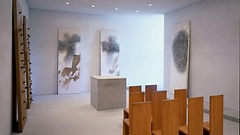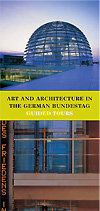Navigationspfad: Homepage > Art and History > Art > Artists
Günther Uecker
born 1930 in Wendorf/Mecklenburg, lives in Düsseldorf and Berlin.
Inspired by theological tradition and with great artistic and architectonic economy, Günther Uecker has succeeded in creating a room of silence for the Reichstag Building which invites people to engage in reflection and meditation.
Through a fissure in a dividing wall in front of the side windows, Uecker allows daylight to filter indirectly into the room, which thus, in contrast to Norman Foster’s light-flooded architecture, assumes the mystical aura of an early medieval crypt.
A marking in the floor indicates the direction of east and allows the visitor, by turning at right angles to it, to locate south and face towards Jerusalem and Mecca. The meditation room is thus embedded in a system of spiritual coordinates that links it with some of the world’s major religions – in keeping with its intended use as an inter-denominational place of dialogue between people of different faiths.
The restraint which characterizes the room’s interior is accentuated by powerful sculptural elements such as the altar of sandblasted granite, the chairs and benches designed by Uecker himself, and the seven vertical wooden panels leaning against the wall.
On these panels Günther Uecker has used nails, paint, sand, ashes and stones to make pictorial forms suggestive of both biblical themes and elementary experiences of human existence – condensed to create strikingly evocative and vividly intense images.





